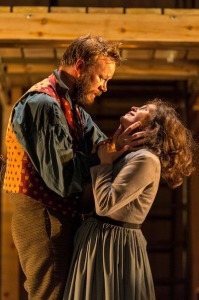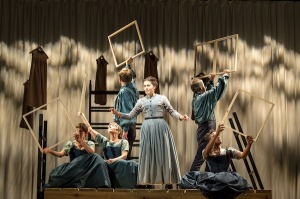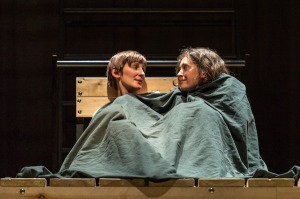Not a girl, alas
by Mika Provata-Carlone
Felix Hayes (Rochester) and Madeleine Worrall (Jane) in Sally Cookson’s Jane Eyre at the National Theatre © Manuel Harla
Our times are times of tremendous change, maturation and unique creative vibrancy for the theatre. Productions have multidimensionality, a plurality of voices and of centres of balance which enthrals us, inspires us, truly lures us to share in the dramatic experience, be more and more an integral, engaged part of a stage that is no longer limited by its conventions.
There is breathtaking, spellbinding innovation in the art and craft of scenic design, in the potentials of dramaturgy, in the fertile cross-breeding between cultures, traditions, historical moments of theatrical development. At its finest, contemporary theatre evokes all there was and all that can be. It makes use of artifice and the naked truth, man and the machine, speech, sound and silence, image and darkness, fiction and history, to compel us to think, feel, yearn for more than what merely seems.
The National Theatre was conceived as the place that would always be at the forefront of such aspiration; as the institution which would render the classics of the past accessible, would offer a platform for foreign drama in translation, foster the creation of modern classics, “stimulate the art of acting” and “further the development of modern drama”; that would above all preserve the “theatrical tradition [from] the emergence of the entertainment industry” as Richard Findlater wrote in 1977. Situated in the non-conventional Southbank Centre, the NT is intended to be a heaven in the wilderness as well as a natural centre of all that is most vital in our culture and thought. While it raises walls of defence against a barbarity of bigotry, against the blindness of a hypocritical elitism and the populist resistance to the power of art to reach as well as elevate, it also demolishes all walls of exclusion – as it did momentously with Tony Harrison’s production of Trackers of Oxyrhynchus, which premiered at Delphi in 1988 and came to the NT in 1989, at a time when margin and centre, old and modern, high and low, the role of art in society, were most vitally at stake.
Cookson conjures a world of everything out of almost nothing. Their visual framework for the play is a sublime, transfixing conceit.”
Sally Cookson’s production of Jane Eyre, first devised for the Bristol Old Vic in a substantially extended version, sets similar aims. Cookson intends to “surprise and challenge audiences” in her productions, adding to books “the theatrical experience” to counterbalance what she calls the inevitable “linearity” of prose. To this purpose, she insists on a “directorial style” which entails as much promise of the miraculous, as it does risk: she “never start[s] with a concrete script” but rather works with her company on loosely structured improvisation which is then transcribed into a scene by a “writer in the room”. Her fundamental premise is a breathlessly dynamic heuristic theatre, where experimentation is meant to enhance the sense of a human here and now, where actors are authors as well as the primal characters behind the dramatis personae.
In Jane Eyre, Cookson and set designer Michael Vale, together with lighting designer Aideen Malone, conjure a world of everything out of almost nothing. Their visual framework for the play is a sublime, transfixing conceit, so powerful in its minimalism that it gives wild, free rein to the audience’s reconstructive imagination: like children, we must be able to see a real, mighty royal castle in a pile of twigs and sticks. Here, rugged builders’ planks, ladders of odd shapes, heights and sizes and steel fixtures create a bare minimum of elevated platforms that evoke an eerie feeling of suspension in space, of a suspended life – very frequently and hauntingly of a hangman’s scaffold. In the underbelly of this precarious edifice, is Benji Bower’s band of musicians huddled around a grand piano. The whole is surrounded by stage wings concealed behind virginal white drapes that are flooded with light, colour or darkness to arresting effect by Malone.
As the scenes succeed one another almost at a gallop, the lightest scenic gestures and the most emphatic, articulate use of lighting transform each time the pile of twigs and sticks into all that the novel contains in its descriptive passages readers have cherished for so long. Grey, murky shadows and a trapdoor leading to the underworld cloud Jane’s birth, her parents’ deaths and her early life, portraits descending suddenly from the ceiling and strong red floodlights mark the space and time at Reed House, spectral girls’ chemises hanging here and there as though to dry, as though to indicate the futile waste of childhood, the loss of innocence or the brutal spiriting away of a life, conjure up Lowood school. An armchair and an ingenious, unexpectedly funny dog (Craig Edwards) tell us we are at Thornfield, while a carefully placed crucifix leaves us in no doubt that we are in the cottage of the St John siblings. Unseen windy landscapes chill us and engross us with their vastness and beauty as a simple skirt is made to flounce or a scarf to fly high, while carriages race past our eyes invisible and massive, as physical theatre and body language are used with hypnotic expertise.
Costumes are bold, perfectly historical, and a regal, post-colonial Bertha Mason (Melanie Marshall) captivates us at her purest and most genuine with her almost preternatural song – both hers and Jane’s, as we realise incisively at the fire scene. There is electrifying force and poetry in the staging.
The production presumes one has read Charlotte Brontë’s novel. We need to know in order to intuitively see through the veils of abstraction. And this is the flaw, the “flawed pleasure” as Jane Shilling wrote a few months ago of Cookson’s Romeo + Juliet at the Rose Theatre. For if we remember Charlotte Brontë’s Jane, her Rochester, her Jane Eyre, the production reels on the verge of being a mere display of theatrical fireworks – very beautiful and skilful, but with perplexing meaningfulness and intentions. We find ourselves in a matrix of allusions and superimposed interpretations which blot our vision and stomp our senses. We hear confusing echoes of Emily Brontë’s Wuthering Heights, Dickens’ David Copperfield and Nicholas Nickleby, Hardy’s Tess of the d’Ubervilles, and Lawrence’s Lady Chatterley’s Lover, through which Jane’s voice is muted, for all the feistiness, single-minded elation and unflinching gaze of Madeleine Worrall in the title role – or rather because of it.
The production presumes one has read Charlotte Brontë’s novel. We need to know in order to intuitively see through the veils of abstraction. And this is the flaw.”
Much of this loss – or dispossession – is due to the acknowledged paradigm behind the performance, Paula Rego’s paintings and prints. Her ‘brutalist’ style in the depiction of women and childhood (with the darkest, most sinister undertones), the conviction that “the picture tells you what is inside you and what you feel sometimes isn’t very nice” as Rego says about her work, takes us to a world of polemic feminism and Soutine-like human forms and feelings. A stimulating world full of pregnant questions, but not the world of Charlotte Brontë. We lose her shrewd exploration of contrasts, such as lineage vs. brutality, shelter vs. oppression, strength and charisma vs. frailty and darkness, freedom vs. belonging, duty vs. happiness, or cold earnest devotion vs. charity. Especially the contrast between what we might call the We vs. what we always seem to fear as the Other.
Characters and the novel’s situations become flat stereotypes with little depth – we lose Mrs Temple who provides the necessary metaphor of right and wrong at Lowood, the governors who dethrone Mr Brocklehurst and initiate social and educational reform. We lose, vitally, the seductive force of Rochester, who is reduced to a gruff physicality that leaves him bemused – and tired. His Byronic mystery, his power to instruct and enchant (as well as dominate) are no longer there, nor is the exquisite, subtle irony of their exchanges, as in the line “Am I hideous, Jane?” from the now mutilated and blind Rochester, to which Jane memorably responds: “Very, sir: you always were, you know.” Gone too is Sir John Eyre’s inheritance, which in the novel allows Jane to return to Thornfield/Ferndean as “a woman of her own”.
Equally jarring are the insistence to portray children on stage as shrill and hysterical dumb creatures, the anachronistic songs, and especially the questionable use of regional accents to make the characters feel “more like us”. The Brontës were certainly revolutionary, but they were reconstructively not subversively so – they rebel for, not against. As Charlotte Brontë writes in the preface to the second edition, her struggle (and Jane’s) is to untangle powerful, vital truths from their twisted, fallen forms. Religion, family, love, education, selfhood, marriage need redefinition rather than rejection.
There is too much of Angria in Cookson’s production to make it into a rapturous, fruitful experience and re-reading. She fails to show the roots of the emotional tensions, and what is a visual and dramatic success (triumph even) does not possess an equivalent psychological depth. “It’s a girl!” we are told at the beginning of the performance as Jane appears on the stage emitting what we are to register as her primordial birth cry. “There was no possibility of taking a walk that day,” is what Charlotte Brontë gave us instead, a startling beginning of disempowerment that will show us just how Jane will make her own walk of life masterfully possible. “It’s a girl!” are the final words on Cookson’s stage, as Jane holds her firstborn in her arms. The feminist twist is too pat – and in fact, in Brontë’s novel it is actually… a boy.
The sheer momentum of this calibre of innovation is thrilling, and it will be equally thrilling to see what Sally Cookson and her company will devise next, when less will hopefully indeed be more, when there will be less narrow idealism and more close reading to set that text magnificently free.
Mika Provata-Carlone is an independent scholar, translator, editor and illustrator, and a contributing editor to Bookanista. She has a doctorate from Princeton University and lives and works in London.
Jane Eyre continues at the National Theatre to Sunday 10 January. More info.



